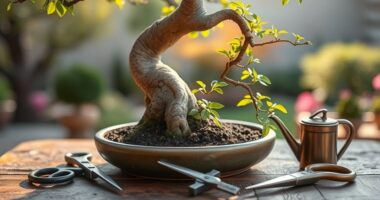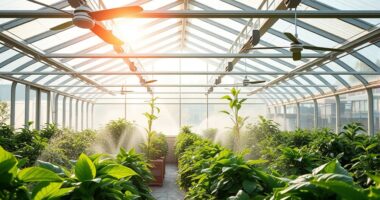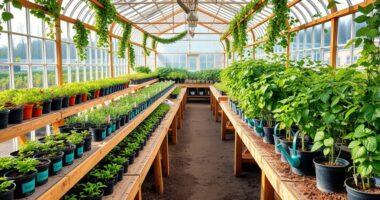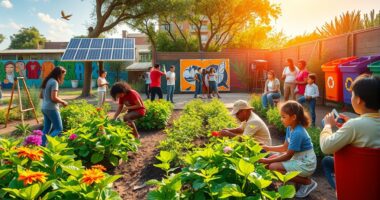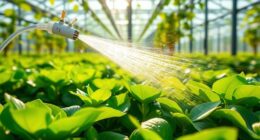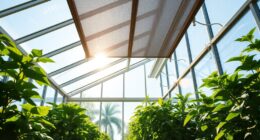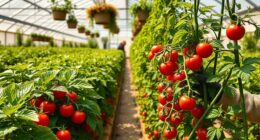When cultivating a thriving garden, I think about key pollinators like bees, butterflies, and hummingbirds. Bees, especially, are important for indoor and outdoor plants, while butterflies enhance biodiversity. Choosing the right wildflowers, like those in the Earth Science Wildflower Pollinator Mix or Burpee's bulk seeds, attracts various species. Creating a pollinator-friendly environment with native plants is essential for success. Let's explore how selecting and supporting these significant pollinators can elevate your gardening experience even further.
Key Takeaways
- Bees, especially native species, are vital for pollination, enhancing fruit and vegetable yields significantly in gardens.
- Butterflies contribute to pollination while also adding beauty and attracting more pollinators to your garden.
- Hummingbirds are attracted to nectar-rich flowers and assist in pollinating a variety of plants, especially in warmer climates.
- Bats play a crucial role in pollinating night-blooming flowers, benefiting ecosystems and enhancing garden diversity.
- Native insects, such as mason bees and leafcutter bees, are effective pollinators and support local biodiversity when encouraged in garden habitats.
Bee Pollinators for Indoor Gardens
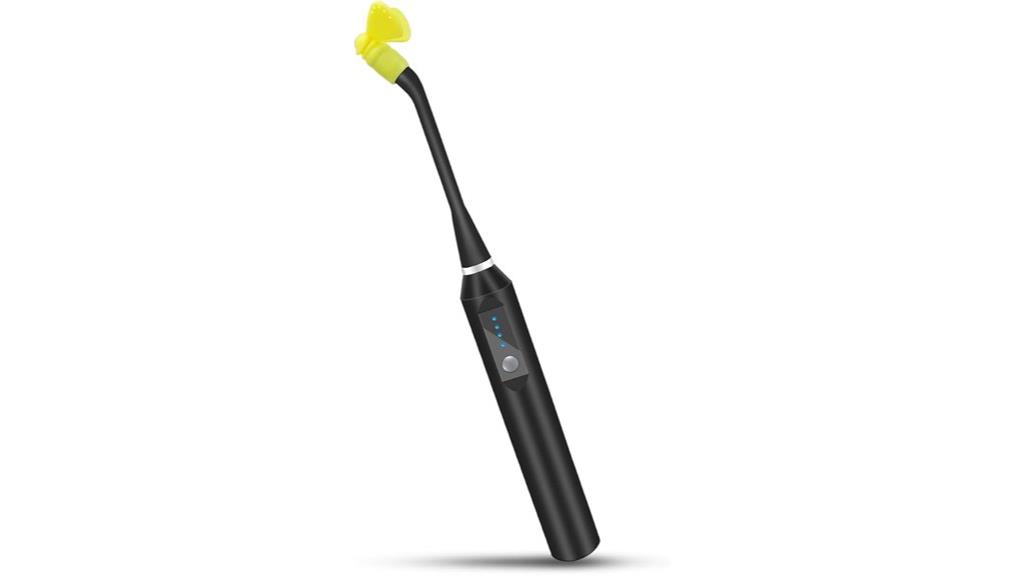
If you're looking to boost your indoor garden's productivity, the custom-tailored bee pollinator is a game changer. This handy tool features a soft brush design that vibrates to gently transfer pollen, ensuring your plants thrive without harming their delicate stamens. I've found it works wonders on tomatoes, peppers, strawberries, and even pumpkins. With a high vibration frequency, it can increase your yields by up to 30%! Plus, it's energy-efficient, charging via USB in just 6-7 hours. Just remember to assemble it correctly for the best results, and enjoy a flourishing indoor garden like never before!
Best For: Indoor gardeners seeking to enhance pollination and increase yields of flowering fruits and vegetables.
Pros:
- High vibration frequency can boost yields by up to 30%.
- Energy-efficient design with USB charging eliminates the need for battery replacements.
- Soft brush design ensures gentle pollen transfer without damaging plants.
Cons:
- Some users reported malfunctioning issues after limited use.
- Poor assembly instructions can lead to suboptimal performance.
- Quality concerns noted by a few customers affecting overall satisfaction.
Earth Science Wildflower Pollinator Mix (6 lb)
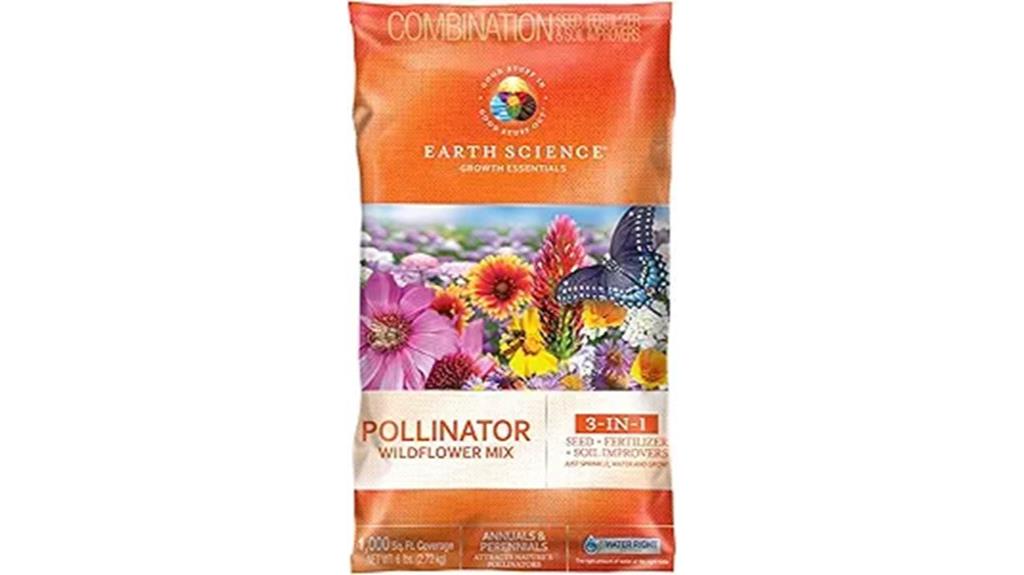
The Earth Science Wildflower Pollinator Mix (6 lb) is perfect for gardeners looking to attract a diverse range of pollinators, such as bees, butterflies, and hummingbirds. This 3-in-1 mix combines wildflower seeds, plant food, and soil conditioners, ensuring your garden thrives. I appreciate its non-GMO and organic features, making it a natural choice for eco-friendly gardening. With moderate watering, I've seen reports of growth in just three days! While some users noted a smaller percentage of wildflower seeds, I believe the potential for vibrant blooms is worth the try. Let's create a pollinator haven together!
Best For: Gardeners seeking to attract pollinators like bees, butterflies, and hummingbirds with an eco-friendly wildflower mix.
Pros:
- Non-GMO and organic ingredients promote eco-friendly gardening practices.
- Reports of quick growth within three days enhance the gardening experience.
- Ideal for creating a vibrant pollinator haven, supporting local ecosystems.
Cons:
- Contains only 3% wildflower seeds, with 97% inert matter, which may disappoint some users.
- Variable success rates reported; some users experienced fewer blooms than expected.
- Moderate watering requirements may be challenging for some gardeners.
Burpee Wildflower Bulk Non-GMO Flower Seeds (25,000 Seeds)
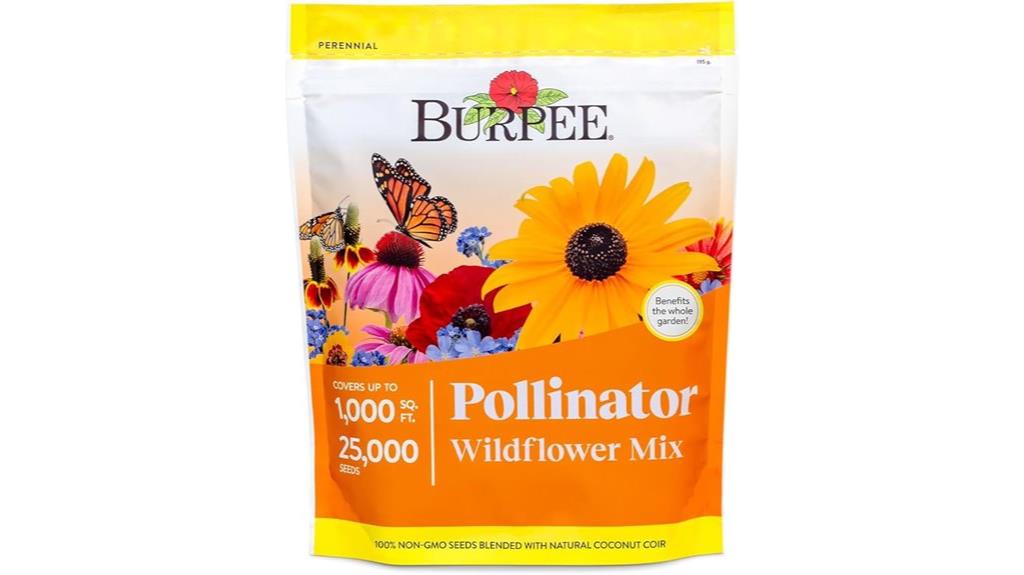
Burpee Wildflower Bulk Non-GMO Flower Seeds, with an impressive 25,000 seeds in one bag, are perfect for gardeners looking to attract a diverse range of pollinators to their space. This mix features 18 varieties, including Echinacea, Blue Flax, and Forget-Me-Not, ensuring vibrant blooms that draw in bees and butterflies. You can easily cover up to 1,000 square feet by scattering the seeds in a sunny area after frost risk. With a germination rate 35% higher than industry standards, you'll see growth in just a week. Just remember to water regularly and enjoy your stunning, low-maintenance garden!
Best For: Gardeners seeking to create a vibrant pollinator-friendly garden with minimal maintenance.
Pros:
- High germination rate: Burpee seeds have a germination rate 35% higher than industry standards, ensuring successful growth.
- Diverse flower mix: Includes 18 different varieties, attracting a wide range of pollinators like bees and butterflies.
- Low maintenance: Users report vibrant blooms with minimal effort, making it ideal for beginner gardeners.
Cons:
- Potential overcrowding: Some users experienced competition with other plants, necessitating thinning of seedlings.
- Patience required: Flowers may take 2.5-3 months to bloom, which may test the patience of some gardeners.
- Soil preparation needed: Requires initial soil preparation and weeding to ensure optimal growth conditions.
Bee Pollinators for Indoor Gardens and Greenhouse Vegetables
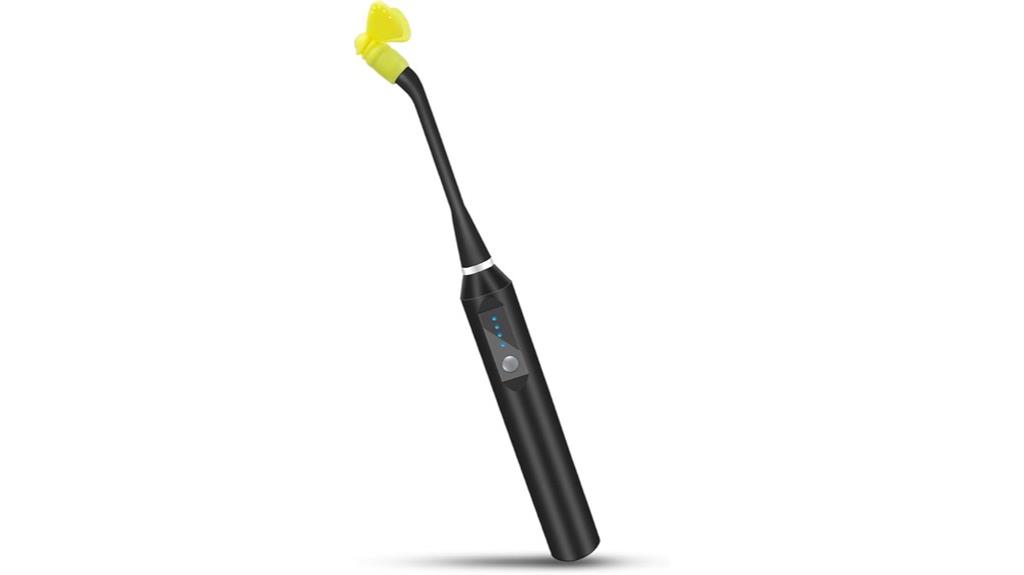
For indoor gardeners and those cultivating greenhouse vegetables, the custom-tailored pollinator stands out as an essential tool. This handy device features a soft brush design that vibrates gently, ensuring efficient pollen transfer without damaging your plants. It works wonders on a variety of flowering fruits and veggies, from tomatoes to strawberries. With a high vibration frequency, it can boost your yields by up to 30%. Plus, the built-in lithium battery charges via USB, saving you from constant replacements. Just remember to assemble it properly, and you're on your way to a bountiful indoor harvest!
Best For: Indoor gardeners and greenhouse vegetable cultivators looking to enhance yield through effective pollination.
Pros:
- Increases yields by up to 30% with efficient pollen transfer.
- USB rechargeable lithium battery eliminates the need for constant battery replacements.
- Versatile design suitable for a wide range of flowering fruits and vegetables.
Cons:
- Some users report malfunctioning issues over time.
- Assembly instructions may be poor, leading to setup difficulties.
- Quality concerns noted by a subset of users affecting overall satisfaction.
The Pollinator Victory Garden: Ecological Gardening for Pollinators
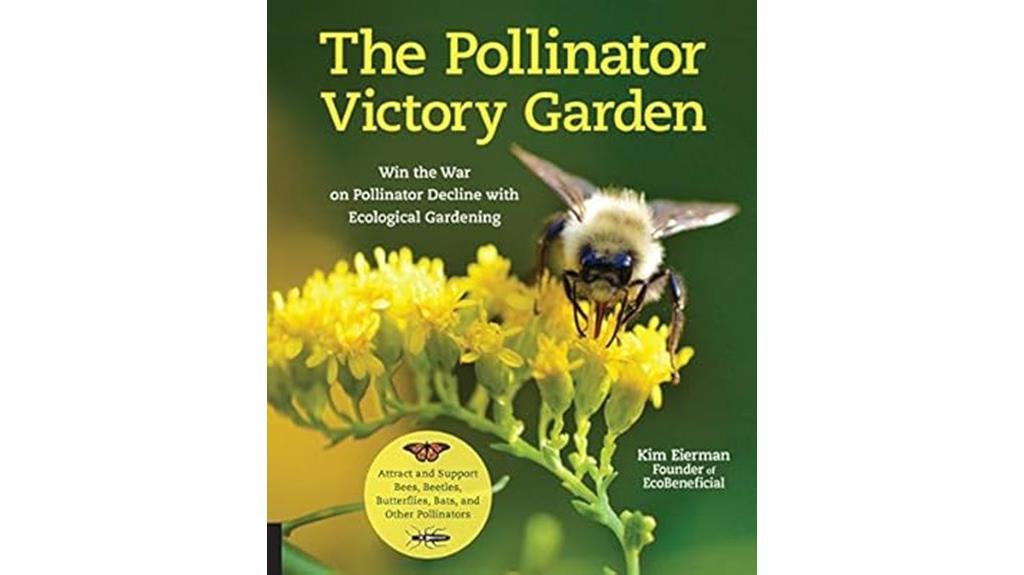
Creating a garden that thrives with pollinators is an enriching experience for anyone passionate about nature and sustainability. I found "The Pollinator Victory Garden" by Kim Eierman to be an incredible resource. It teaches me how to support bees, butterflies, and more by planting native species and creating nesting areas. By incorporating a range of blooming plants throughout the seasons, I can cater to different pollinators' needs. Plus, the book emphasizes avoiding pesticides and reducing lawn space to enhance biodiversity. This journey not only benefits my garden but also contributes to the health of our ecosystem. Let's make a difference together!
Best For: Gardeners and nature enthusiasts looking to create a sustainable and pollinator-friendly garden.
Pros:
- Comprehensive guidance on planting native species and creating habitats for various pollinators.
- Emphasizes ecological practices such as avoiding pesticides and reducing lawn space to promote biodiversity.
- Well-organized and beautifully illustrated, making it accessible for both novice and experienced gardeners.
Cons:
- Some readers outside of North America may find limited applicability due to region-specific references.
- May require additional resources for gardeners in areas with different pollinator species and gardening practices.
- The focus on American gardening may lead to disappointment for UK readers seeking localized advice.
Insect Hotel – Pollinator House for Bees and Butterflies
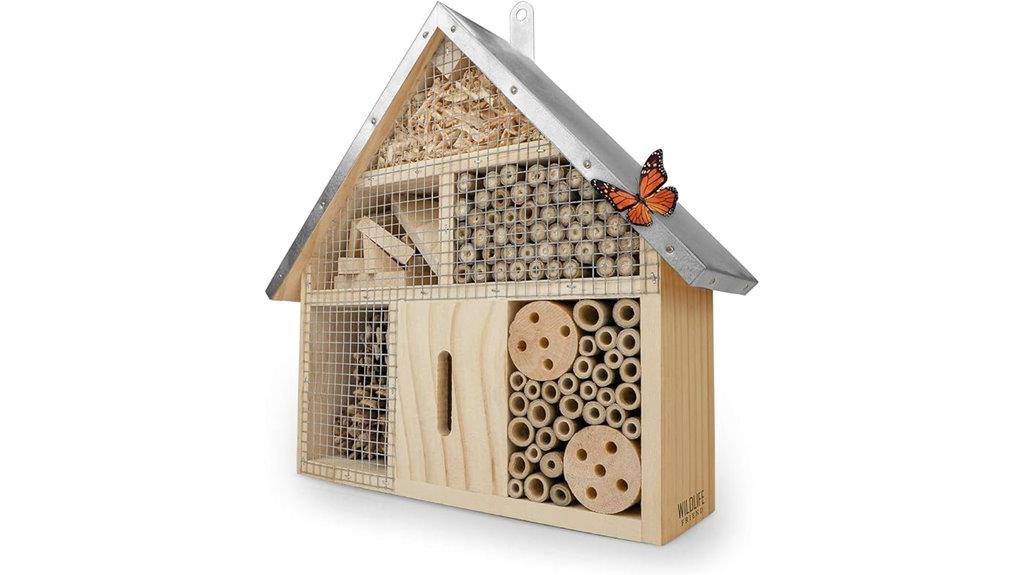
If you're looking to attract essential pollinators like bees and butterflies to your garden, the Wildlife Friend Insect Hotel is an excellent choice. Measuring 10 x 3 x 11 inches, this beautifully crafted wooden and metal shelter provides year-round habitat for various insects. Its extended metal roof protects from rain, while the interior features wood, wood wool, bamboo tubes, and pine cones, catering to all insect needs. Installation is a breeze with a sturdy mounting hook. By adding this hotel to your outdoor space, you'll create a welcoming sanctuary that promotes biodiversity and helps sustain a thriving ecosystem.
Best For: Garden enthusiasts and eco-conscious individuals looking to support pollinator populations in their outdoor spaces.
Pros:
- Provides a year-round habitat for essential pollinators like bees, butterflies, and ladybugs.
- Easy to install with a sturdy mounting hook and pre-drilled holes.
- Crafted from natural materials, enhancing the aesthetics of any garden or balcony.
Cons:
- Some customers have expressed concerns about packaging and construction quality.
- May require periodic maintenance to ensure durability and effectiveness.
- Limited color options, as it is only available in brown.
Attracting Native Pollinators: The Xerces Society Guide
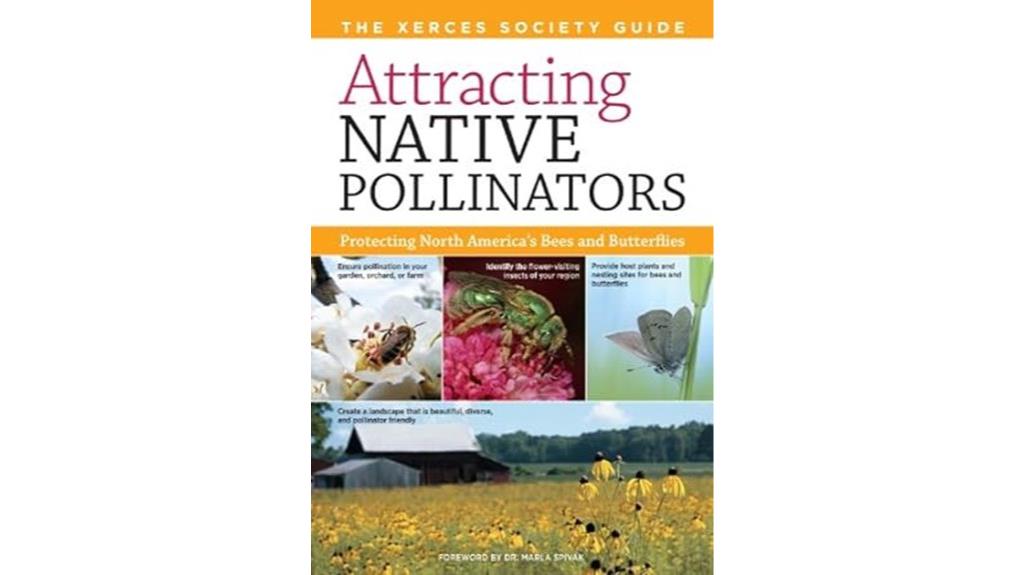
The Xerces Society's "Attracting Native Pollinators" is an invaluable resource for gardeners who want to enhance biodiversity and support local ecosystems. This guide provides practical advice on creating habitats for native bees and butterflies, including how to build nesting sites and choose the right plants. I found its field guide section particularly helpful for identifying native pollinators, inspiring me to protect their habitats. The stunning images and straightforward writing make it accessible for everyone. By joining the Xerces Society, I've connected with a community dedicated to pollinator conservation, proving that even small efforts can lead to big impacts in our gardens.
Best For: Gardeners and conservation enthusiasts seeking to enhance biodiversity and support native pollinator populations.
Pros:
- Provides practical advice on creating habitats for native bees and butterflies, making it easy for anyone to implement.
- Features a detailed field guide for identifying native pollinators, fostering awareness and conservation efforts.
- Includes stunning imagery and accessible writing, suitable for both beginners and experienced gardeners.
Cons:
- Some readers may find the formal text style a bit dense due to its committee-written nature.
- Limited focus on non-native pollinators may leave some readers wanting more comprehensive coverage.
- Requires commitment and effort to fully implement the habitat creation strategies suggested in the guide.
10 Pack Pollination Brush for Hydroponic Gardens
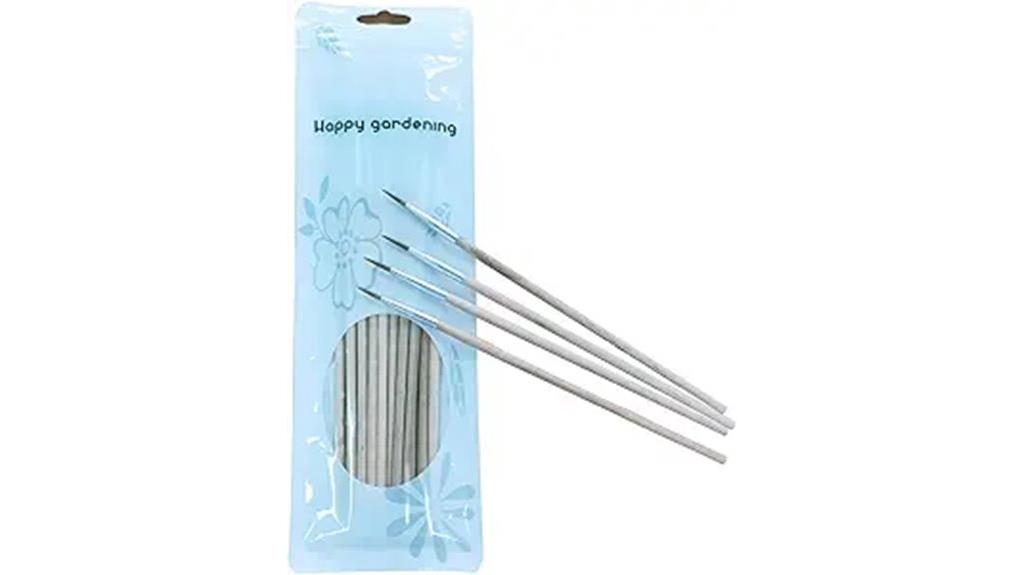
For anyone cultivating indoor hydroponic gardens, the 10 Pack Pollination Brush is an essential tool that can greatly enhance your gardening success. I've found these brushes perfect for ensuring my tomatoes and peppers get the pollination they need, especially when natural pollinators aren't around. Each brush is just the right length for reaching larger flowers, like squash, and the soft bristles make pollination gentle and effective. Plus, with ten brushes in the pack, I can easily keep them near different plants without mixing them up. They're easy to clean and come with a lifetime replacement guarantee, offering great value for my gardening efforts.
Best For: Indoor hydroponic gardeners looking to enhance pollination for their flowering plants like tomatoes and peppers.
Pros:
- Enhances yield: Increases fruiting rates for various flowering plants.
- Easy to clean: Simply rinse under water for quick maintenance.
- Lifetime replacement guarantee: Ensures customer satisfaction and long-term use.
Cons:
- Limited to hydroponic use: Not suitable for outdoor gardens or traditional soil-based systems.
- Requires manual application: Pollination is not automatic and needs to be done by the user.
- Soft bristles may wear out: Frequent use might lead to bristle degradation over time.
Survival Garden Seeds Pollinator Flower Collection (3 Seed Packs)

Attracting a vibrant array of pollinators to your garden is effortless with the Survival Garden Seeds Pollinator Flower Collection, which includes three carefully curated seed packs. This collection features nectar-rich annuals and perennials, perfect for hummingbirds, butterflies, and various bee species, including monarchs and honeybees. I love the Butterfly Mix with its stunning zinnias and marigolds, while the Bees Mix offers delightful California poppies. The Hummingbird Mix, packed with vibrant scarlet sage, truly brings life to my garden. With non-GMO heirloom seeds suited for USDA zones 4-11, I've enjoyed high germination rates and a flourishing, colorful space teeming with activity!
Best For: Gardeners looking to attract a variety of pollinators, including butterflies, bees, and hummingbirds, to their outdoor spaces.
Pros:
- High germination rates and non-GMO heirloom seeds ensure vibrant growth and sustainability.
- A diverse mix of flowers caters to different pollinator species, enhancing garden biodiversity.
- Easy to plant and maintain, providing an aesthetically appealing garden from spring to fall.
Cons:
- Some customers reported missing seed packets in their orders.
- Requires specific growing conditions (full sun and loam soil) that may not be available in all gardens.
- Limited to USDA Hardiness Zones 4-11, which may exclude some regions from successful cultivation.
World of Pollinators: A Guide for Explorers of All Ages

Exploring the fascinating world of pollinators can be incredibly rewarding, especially for families with young children enthusiastic to learn. "World of Pollinators" stands out as an invaluable resource, offering hands-on activities that spark curiosity and encourage bonding through gardening. This book's engaging projects are perfect for kids aged 6-10, but even older readers will find valuable insights. I loved the bold photographs and easy-to-read sections that made learning fun for my family. We even hatched a monarch butterfly together! I highly recommend gifting this book along with pollinator seeds to inspire excitement for gardening and pollination in your community.
Best For: Families with children aged 6-10 who are eager to learn about pollination and engage in hands-on activities.
Pros:
- Engaging hands-on activities that promote family bonding and learning.
- Beautifully illustrated with bold color photographs that captivate young readers.
- Suitable for a wide range of ages, making it a versatile educational tool for everyone from children to adults.
Cons:
- Some readers may find the content too basic if they are seeking advanced information on pollination.
- The focus on younger audiences might not satisfy older readers looking for in-depth scientific analysis.
- Limited availability in certain regions could make it difficult for some interested families to obtain a copy.
Pollinator Gardening for the South: Creating Sustainable Habitats

Gardening in the South offers unique challenges and rewards, especially when you're focused on creating sustainable habitats for pollinators. I found "Pollinator Gardening for the South" to be an invaluable resource, combining humor with practical advice that's perfect for beginners like me. It emphasizes the importance of native plants while steering clear of non-natives, which can disrupt local ecosystems. Professionals, including landscapers, recommend this book for its engaging writing and useful tips. If you're looking for a thoughtful gift for gardening enthusiasts, this one's a winner. Let's nurture our gardens and support those essential pollinators together!
Best For: Beginners in southern gardening who want to create sustainable habitats for pollinators while avoiding non-native plants.
Pros:
- Engaging writing style that combines humor with practical advice.
- Strong emphasis on the importance of using native plants to protect local ecosystems.
- Highly recommended by professionals in landscaping and gardening.
Cons:
- May not provide advanced techniques for seasoned gardeners.
- Focused specifically on southern gardening, limiting its applicability in other regions.
- Some readers might prefer more detailed illustrations or photos to accompany the text.
Factors to Consider When Choosing Pollinators

When selecting pollinators for my garden, I think about several key factors. It's crucial to take into account the type of pollinator, how well they fit into my environment, and what plants they'll thrive with. Plus, I need to keep in mind their maintenance needs and seasonal availability to guarantee a flourishing garden year-round.
Pollinator Type Selection
Choosing the right pollinators for your garden is essential for maximizing plant health and productivity. I always start by considering the specific plants I have. Some pollinators, like native bees, are attracted to particular flowers based on their shape and color, so I choose plants that suit these bees, like mason and bumblebees. If my garden features tubular flowers, I know hummingbirds will thrive. I also include host plants for butterflies, which attract adults and support their larvae. It's important to remember that different species have varying activity times; bees are busy during the day, while moths come out at dusk. By selecting the right pollinators, my garden flourishes with vibrant blooms and healthy plants.
Environmental Suitability
To create a thriving garden, I always consider the environmental suitability for my chosen pollinators. First, I look at the local climate and weather patterns, since different species thrive in specific temperature ranges and humidity levels. Next, I assess the availability of food sources like nectar and pollen from native flowering plants; these are essential for sustaining pollinators. Habitat diversity is also important; I make certain there are nesting sites and shelter, like undisturbed soil. I keep an eye on pesticide use in my area, as high levels can harm pollinators. Finally, I identify blooming seasons of plants to provide a continuous supply of resources, supporting the pollinators' life cycles and roles in my garden ecosystem.
Plant Compatibility
Understanding the compatibility between pollinators and plants is essential for maximizing the health and productivity of my garden. When I select pollinators, I consider the specific types of flowers I'm cultivating. Different pollinators are drawn to distinct flower shapes, colors, and sizes, which greatly impacts successful pollination. I've found that native pollinators, like certain bee species, are more effective with local plants. Timing also matters; I make sure my flowering plants coincide with the active periods of pollinators. For example, hummingbirds love tubular flowers, while butterflies prefer flat clusters. By maintaining a diverse range of plant species, I can support various pollinators, improving yield and promoting biodiversity in my garden.
Maintenance Requirements
When selecting pollinators for my garden, I keep their maintenance requirements in mind to guarantee a thriving ecosystem. I've noticed that some pollinators, like native wildflowers, need less care once established, while others may require regular watering and soil attention. Installing habitats, such as insect hotels, has proven low-maintenance since they naturally shelter and nest pollinators. I always monitor my flowering plants to verify they're healthy and to catch any pest issues early. Choosing non-invasive, native plants has greatly reduced my upkeep since they're more resilient to local challenges. If I'm indoors or in a controlled setting, I may use manual pollination tools, but that's more of an exception than a rule in my outdoor garden.
Seasonal Availability
Choosing the right pollinators for my garden means considering their seasonal availability, as this can make a big difference in the success of my plants. Many pollinators, like honeybees, are active year-round in warmer climates, while others, such as bumblebees, have shorter active periods that align with specific flowering seasons. To attract and sustain pollinators, I focus on planting a succession of blooms, ensuring flowers are available when pollinators are active. Weather conditions also play a role; extreme cold or heavy rain can reduce their foraging behavior. By understanding the local ecosystem and the lifecycles of native pollinators, I can better plan my planting to coincide with their activity, boosting my garden's productivity.
Frequently Asked Questions
What Other Animals Help With Pollination Besides Bees?
When I think about pollination, I realize it's not just bees that play a role. I've seen butterflies, hummingbirds, and even certain bats helping flowers thrive. These animals visit blooms for nectar and, in the process, transfer pollen. I've noticed that having a diverse range of pollinators in my garden really enhances its health. So, if you're interested in boosting your plants, consider attracting these other amazing pollinators!
How Can I Create a Pollinator-Friendly Environment?
Imagine a vibrant garden buzzing with life, where butterflies dance and hummingbirds flit from flower to flower. To create a pollinator-friendly environment, I've planted a variety of native flowers that bloom at different times. I've avoided pesticides and set up small water sources, like shallow dishes with pebbles. With patches of bare soil for ground-nesting bees and a diverse array of plants, my garden becomes a haven for these essential creatures.
What Time of Year Is Best for Planting Pollinator Plants?
I've found that the best time for planting pollinator plants is in the spring, after the last frost. This gives them a chance to establish roots and bloom throughout the warmer months. However, some fall planting can also work well, especially for certain perennials. I like to contemplate my local climate and choose native plants that thrive in my area. This way, I'm not only helping pollinators but also enhancing my garden's beauty.
How Do Urban Areas Affect Pollinator Populations?
Isn't it ironic? Urban jungles, buzzing with life, often stifle pollinators. I've noticed that while cities offer some refuge, they also create barriers. Paved surfaces, pollution, and limited green spaces make it tough for these little heroes to thrive. I've seen how fragmented habitats can disrupt their journeys. However, when we add gardens and wildflowers to our urban spaces, we can invite them back, creating a healthier ecosystem for all.
Are There Any Specific Plants That Attract Butterflies?
If I want to attract butterflies, I've found that planting milkweed, coneflowers, and lantana really makes a difference. These plants not only draw butterflies in but also provide them with essential nectar. I love watching them flutter around my garden. It's even better knowing that I'm helping their populations thrive. So, if you're looking to create a butterfly-friendly space, these plants are definitely worth considering!
Conclusion
In my journey to create a thriving garden, I've learned that embracing a diverse range of pollinators is essential. It's not just about planting flowers; it's about fostering a harmonious ecosystem. By understanding the unique roles of bees, butterflies, and other pollinators, I've realized that our gardens can reflect the balance of nature. Let's cultivate spaces that not only beautify our surroundings but also support the intricate web of life that sustains us all.


